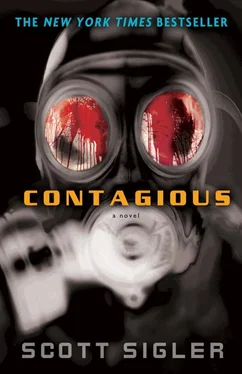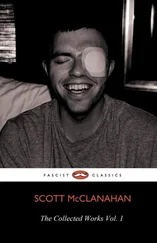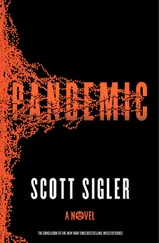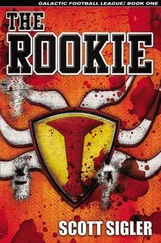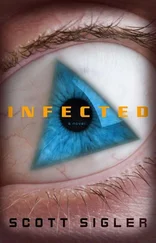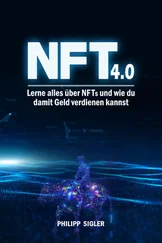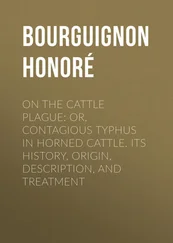He was hot, he was sleepy, the conditions were crap—not a good combination when his whole life sat in the passenger seat next to him.
Who was following him? Who?
Donald pulled off the highway into a rest stop near Bay City. He exited slowly, seeing which cars behind him did the same. None did. They must have known he was onto them.
Or maybe he was acting crazy…. No one was following him. That was just nuts.
He pulled up to the rest stop building and parked gently, so as not to wake his daughter. Cars packed the lot. Some were still running, tailpipes trailing exhaust, windshield wipers fighting the constant battle against icy clumps. Other drivers had thrown in the towel, shutting off the engines and letting the freezing rain cover their cars in a thin, bumpy sheet of ice.
Since he was here, maybe he could just get some sleep. He shouldn’t be driving when he felt like this. What if he fell asleep at the wheel?
He quietly opened the door and headed to the trunk, shoulders hunched against the frigid, driving rain. He stopped halfway, face scrunching in pain and head twitching to the left until his ear touched his shoulder. Another shooting pain, this one a real doozy. It faded slowly. By the time it was gone, Donald’s jacket was nearly soaked. He cursed his brother for making him sick, then opened the trunk and pulled out a sleeping bag.
Darting back into the car, he removed his wet coat before spreading half of the sleeping bag on his daughter. He spread the other half on himself, coughed, blew his nose, cursed his brother one more time, then laid his head against the headrest.
Just an hour or two, a quick nap while the storm blew over and the snowplows cleared the highways, and then they’d be back on the road.
Inside Donny’s body,things were rapidly shifting from Fucking Bad to Even Fucking Worse.
The problem began with his telomeres. What is a telomere? Picture the little plastic bits on the end of your shoelaces. Imagine each time you tie your shoes, you have to clip off a little bit of that plastic part to get it to go through the lace holes. After you’ve done this enough times, the plastic tip is gone and the shoelace starts to unravel. Once the laces unravel enough, it’s impossible to tie your shoes, and you walk around looking like a goober.
Telomeres are the DNA equivalent of those plastic shoelace bits. When your cells divide via mitosis, the chromosomes of those cells also divide. One set of chromosomes divides to become two half-sets. Your body duplicates each half-set, and one cell becomes two daughter cells.
Simple enough, but there’s a catch.
When your chromosomes split, it’s like a zipper splitting into two parts. Enzymes flood the newly divided chromosome and fill in the missing zipper halves, one little zipper tooth at a time. Problem is, the zipper teeth can’t reach all the way to the end—there has to be a little cap there, and that cap is the last bit of the repetitive telomere. On the next cell division, that last bit of telomere is discarded just like the snipped bit of the plastic shoelace.
If cells with shortened telomeres continue to divide, bad stuff can happen. The cell might enter into apoptosis (the natural kind, not the triangle-induced chain-reaction kind). Worse, damage to a critical gene might make the cell cancerous. This can happen in skin cells, muscle cells, lung cells… and even stem cells.
When a stem cell splits into two daughter cells, it uses a process called differentiation to make one daughter cell another stem cell, while the other becomes any number of good things—muscle, bone, nerve cells, whatever. Stem cells are just funky that way. But as they divide, they suffer the same telomere reduction as any other cell.
As you get older and cells continue to divide, those telomeres shorten and problems become more likely. We have a simple word for this phenomenon: aging. Cells with telomeres that are too short stop dividing and stop replenishing themselves. This is why your skin gets thin when you age, because the cells stop replicating as effectively—they have used up their telomeres during your preceeding years of life.
Or to think of it in simpler terms, a copy of a copy of a copy can get pretty messed up.
Triangles used many stem cells to make their cellulose framework and become full-blown hatchlings. Sometimes old stem-cell lines produced bad shit: defective cells, even cancerous cells. When that happened, the reader-balls and herders and builders identified bad stem cells and simply removed them.
The stem cells producing crawler strands, on the other hand, worked as solo operatives. They were in a hurry. Herders focused on finding and converting more stem cells, not doing quality control.
Donald, being the oldest of the three infected Jewells, had more shortened telomeres than Betty, and far more than Chelsea. Most of his modified stem cells produced defective muscle strands. Some of these strands were dead on arrival, just floating bits. Others lived long enough to send and receive the “I am here” signal and join up with other strands. Still others made it to full crawler size and began their mission along the nerves, although this effort alone was usually enough to make them shut down after a little bit of distance.
And when they shut down, the rot began.
Slowly at first, a low-level exponential reaction. But as the number of dead strands grew, so did the level of rot-inducing chemicals.
Each modified muscle strand carried both the apoptosis catalyst and a strong counterchemical that blocked the catalyst. If there were more living strands than dead strands, the apoptosis couldn’t gain a foothold. But when there were more dead strands than living strands, that balance tipped the other way.
Throughout Donny’s body that balance was tipping fast. Tiny areas of cell death expanded and multiplied. Particularly in his left hand, the apoptosis compounded on itself and started to spiral out of control.
While he slept, Donny Jewell began to dissolve from the inside out.
Zero casualties. Well, one if you counted Private Domkus tripping on a branch and spraining his ankle, but other than that, nothing. So if it was his most successful hatchling encounter yet, why did Colonel Charlie Ogden feel so anxious?
Air transport had pulled all of Whiskey and X-Ray companies out of Marinesco and taken them back to Fort Bragg. North Carolina wasn’t exactly a central location for the missions, but it wasn’t that far, only a forty-five-minute flight to Detroit on a C-17 Globemaster transport jet.
Fort Bragg was a big base. Big enough to sequester an entire battalion for five weeks and counting. Aside from missions, the men hadn’t left the base or had any contact with people outside the unit save for CIA-screened letters, or CIA-monitored phone calls to immediate family only. Ogden was no exception—he hadn’t seen his wife in over a month. It sucked, but that was war.
Fort Bragg also housed the USASOC, the United States Army Special Operations Command. Unconventional warfare, special reconnaissance, antiterrorism—all kinds of aircraft, coming and going at all hours. No one asked where they went, no one asked why they went. That was life 24/7 for the USASOC, and it provided ideal cover for Project Tangram operations.
Throw in all the aircraft available at the adjacent Pope Air Force Base, including plenty of those C-17s, and you had a perfect mix—built-in secrecy, endless options for transport. The DOMREC came and went; no one wondered why.
Ogden sat alone in his quarters, performing his nightly ritual. It consisted of three things:
A letter to his wife.
The Bible.
Читать дальше
